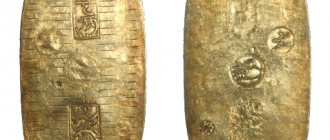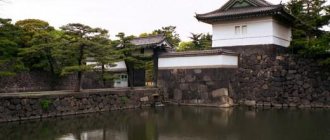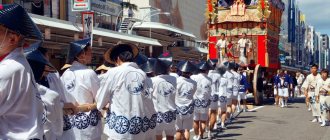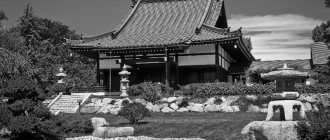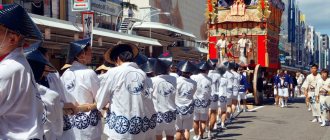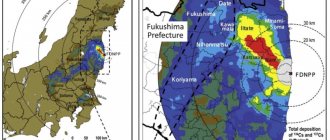By the middle of the 19th century. Japan remained a “closed” country. The shogun, in whose hands all power was concentrated, pursued a policy of self-isolation. This led to Japan's economic and technical backwardness. Under pressure from European countries, which at that time pursued an active colonial policy, she was forced to sign unequal treaties. In 1854, ports were opened to the United States, and relations were subsequently established with Great Britain, Holland and the Russian Empire.
The penetration of cheap European goods into the Japanese market caused the decline of local manufacturing and production. The worsening financial crisis caused social tension in the country. Dissatisfaction with the shogun's rule grew. More and more often there were demands to expel foreigners, in whom peasants and townspeople saw the reason for their impoverishment. At the end of 1866 - beginning of 1867. Peasant protests acquired a special scope. Some cities refused to obey the authorities.
Promulgation of the Constitution. Artist T. Chikanobu
Government
In February 1868, the Imperial Government declared to foreign countries that it was now legitimate. On April 6, 1868, the Emperor issued the Five Point Oath, setting out in it the basic principles of the political course.
Meiji Principles:
- collegial management;
- participation of estates in the development of solutions;
- rejection of xenophobia and compliance with international law;
- openness to the world to gain new knowledge.
Finished works on a similar topic
- Coursework: Meiji Restoration 480 rub.
- Abstract Meiji Restoration 250 rub.
- Test paper Meiji Restoration 200 rub.
Receive completed work or specialist advice on your educational project Find out the cost
On June 11, 1868, a new government structure was approved. In the US Constitution, the Japanese borrowed the formal division of government power into legislative, executive and judicial. Officials were required to be re-elected every 4 years.
Note 1
In September 1868, the city of Edo was renamed Tokyo, and in October the motto of the government was adopted - Meiji. On September 3, 1869, the Emperor moved the capital from Kyoto to Tokyo.
Despite the updates in the management system, the government was in no hurry to reform society. On April 7, 1868, it published five announcements in which it set out traditional provisions based on Confucian morality. The government called on citizens to obey their superiors, respect their elders, and be faithful in marriage; it banned public organizations, rallies, and the practice of Christianity.
Administrative reform
To form a unitary Japan, the elimination of the federalist structure was necessary. During the civil war, the government confiscated the shogunate's properties, which were divided into prefectures. But the territories of the principalities remained outside control. On January 20, 1869, four pro-government daimyos submitted a petition declaring that everything belonged to the Emperor. In February 1869, officials proposed to the Emperor to subordinate their territories to the government. The daimyos from Satsuma, Tosa, Choshu and Hizen agreed to the proposal, returning the lands to the monarch along with the population. In July 1868, the government ordered the other daimyo to do the same, which was carried out without resistance. Only twelve princes did not voluntarily hand over the land registers, but later they obeyed the order.
— — Do you need help creating a study plan? — Specify a topic and receive a response in 15 minutes — — — — — — get help — —
In exchange for lands, princes became heads of central government offices in the regions and received a salary. Although the lands were transferred to the state, the khans themselves were not abolished. Daimyo retained the right to collect taxes and form troops on entrusted lands, thus remaining semi-autonomous. This half-hearted policy caused discontent in the regions. On August 29, 1871, the government proclaimed the establishment of prefectures instead of khans. The daimyo were moved to Tokyo, and dependent governors were appointed in their places. By 1888, the number of prefectures was reduced from 306 to 47, Hokkaido was allocated a special district, and the cities of Tokyo, Kyoto and Osaka were equated to prefectures.
Overthrow of the Shogunate
Patriotic samurai were dissatisfied with the shogun and foreigners. Having put forward the slogan of restoring imperial power, they united around the 15-year-old Emperor Mutsuhito. On the night of January 2-3, 1868, a most important event occurred in the history of Japan - a decree was announced on the “restoration” (restoration) of imperial power, the abolition of the shogunate and the establishment of a new government. The shogun did not comply, and civil war broke out in the country. In the summer of 1869, the shogun admitted defeat. The military-feudal system of the shogunate ceased to exist.
American Squadron Commander Perry meets with representatives of the Japanese Emperor
The restoration of the emperor's power went down in history as the Meiji Restoration. Meiji means "enlightened rule" in Japanese. (Remember where you have already heard about it.) This is the name given to the era of the reign of Emperor Mutsuhito (1868-1912). These events are sometimes called the Meiji Revolution.
Mutsuhito (1852-1912) was the first emperor of Japan after the overthrow of the Tokugawa shogunate. After his death he became known as Emperor Meiji
Government reform
The structure of the Japanese government of the 8th century was taken as the basis for the new vertical of executive power. On August 15, 1869, the government was divided into three chambers.
The Main Chamber had the functions of a cabinet of ministers. It included a great minister of state, ministers of the right and left, and advisers. The left chamber was the legislative body. The right chamber included eight ministries. Most of the positions in the government were occupied by people from the principalities of Satsuma, Choshu, Tosa and Hizen.
Constitution of the Empire
Industrial enterprises were founded like mushrooms after rain. In the recently closed Japan, fashion for European clothing and a European lifestyle appeared. True, many believed that this was damaging to traditional values, and such fears were not unfounded.
In 1872, Japan switched to the Gregorian calendar, and newspapers and magazines began to be published in the capital. Foreign delegations were received in Tokyo, and a special ceremony was developed for the meetings of guests with the emperor, which, while emphasizing the importance of the figure of the monarch, should at the same time not affect the dignity of foreigners.
The Emperor of Japan receives the French military delegation at the Kyoto Imperial Palace. Photo: Commons.wikimedia.org
In the international arena, Japan sought to revise enslaving trade agreements and create an equal partnership.
In 1889, the Constitution of the Empire of Japan was introduced. In addition to defining the fundamentals of the legal status of the emperor and executive authorities, it established a list of fundamental rights and freedoms of Japanese subjects, introduced into the system of government bodies a parliament with legislative power, the lower house of which was elected by the population, and also established an independent court. The Constitution came into force in 1890.
Emperor Meiji in 1890. Photo: Commons.wikimedia.org
Military reform
The most important task of the imperial government was the organization of a new combat-ready army. The troops of the principalities, consisting of samurai, were reassigned to the Ministry of War. On January 10, 1873, the government introduced universal conscription. All men over the age of 20 were required to perform military service, regardless of social origin. Only heads of families and their heirs, students, officials, students and persons who paid a ransom of 270 yen were released.
At the same time, police units were created. Until 1872 they were subordinate to the Ministry of Justice, and then to the Ministry of Internal Affairs.
Social reforms
The imperial government pursued an active social policy. On June 25, 1869, two privileged classes were formed - titled and untitled nobility. The first included the capital's aristocrats and former daimyos, the second included the middle and small samurai. In this way, the government tried to overcome the confrontation between samurai and aristocrats and eliminate the medieval “master-servant” model.
The imperial government also announced the equality of peasants, artisans and merchants, regardless of occupation and position. In 1871, the government classified them as pariahs who had been discriminated against during the Edo period. The common people were allowed to have surnames, which previously were exclusively among samurai, and the nobility were allowed inter-class marriages. Restrictions on travel and changing professions have been lifted.
The nobility was completely supported by the state. It received an annual pension amounting to 30% of the country's budget. To ease this financial burden, in 1873 the government published the “Law for the Return of Pensions to the Emperor,” obliging the nobles to refuse to receive pensions in exchange for one-time bonuses. But the problem was not solved, and the debt for pension payments was growing, so the authorities in 1876 finally canceled their accrual and payments. The legal difference between samurai and common people disappeared. To ensure their existence, part of the privileged class became employees: clerks, police officers or teachers. Many took up farming. Those who went into commerce quickly went bankrupt due to lack of skills. To save samurai, the government provided subsidies and encouraged the development of semi-wild Hokkaido.
Note 2
But these measures were not enough, which in the future became the cause of unrest.
Japan at the turn of the century
By the beginning of the 19th century. Japan was a centralized feudal state located mainly on four large islands - Honshu, Kyushu, Shikoku and Hokkaido. The emperor was nominally considered the head of state. However, in fact, power rested with the shogun - the commander-in-chief and highest official with legislative, executive-administrative and fiscal powers.
The position of shogun was hereditary and belonged to the Tokugawa dynasty. Back at the beginning of the 17th century. the representative of this family, Ieyasu Tokugawa, managed to end the feudal strife of the Japanese princes and unite the country. Since then, Japan has been a feudal-absolutist state led by a shogun. The functions of the emperor were limited to carrying out religious ceremonies.
The feudal house of Tokugawa was the largest landowner. He owned 1/4 of the country's land fund, large mines and mines, which determined the basis of Tokugawa's economic power.
Society was strictly divided into classes: nobles, peasants, artisans and traders.
The military-feudal class was dominant. At the same time, the nobility was not homogeneous in composition and, in turn, was divided into large, influential princes - daimyo' and their small-scale vassals. Feudal principalities were independent administrative and economic units. The daimyo, who stood at the head of the principality, was actually the owner of all the land. In his principality, he had broad powers: he exercised supreme administrative power, established and collected taxes, administered court, minted his own coins, and maintained an army.
The administrative apparatus and military squad were formed from loyal service nobles - bushi. They concentrated mainly in cities - the residences of princes, receiving wages in rice for their service. At the same time, part of the bushi owned their own small plots of land.
The bulk of Japan's population were peasants who were in feudal dependence. They were only hereditary holders of the land and bore the main burden of taxes: they paid food and cash rents, and worked in the fields of the daimyo and bushi.
The urban population—artisans and traders—was even more disenfranchised. Craftsmen were united into workshops and paid high taxes to the state. Merchants were considered the lowest class. Any warrior-nobleman could kill an artisan or merchant with impunity only for an attitude that seemed disrespectful.
From the second half of the 18th century. under conditions of further political centralization, the process of decomposition of the feudal structure began. New, capitalist relations were taking shape. The subsistence economy, which served as the basis of the feudal system, was being destroyed, commodity-money relations were intensively developing, and internal trade was expanding.
New phenomena in the economy have given rise to changes in the social sphere. The decomposition of the feudal-class organization of society and the formation of a new class began - the bourgeois class. The changes affected all classes of Japanese society.
In conditions of long-term peace, keeping the number of military squads at the same level was unnecessary; it inevitably declined. In this regard, many professional warriors lost their overlord - breadwinner, turning into the so-called ronin - “lost people”, and were forced, giving up their tribal class privileges, to engage in other types of activities - trade, usury, production, i.e. capitalist entrepreneurship, or become people of liberal professions - teachers, doctors, office workers, increasing the ranks of those dissatisfied with the social policy of the shogunate.
The upper strata of the nobility, as commodity-money relations developed, sought to increase monetary resources. Some built manufactories, established a monopoly on profitable production products, transferred peasants from natural to cash rent, which contributed to the development of commodity production.
Under the influence of the growth of commodity-money relations from the second half of the 18th century. The process of differentiation of the Japanese peasantry also intensified. The need to pay quitrent in money forced peasants to seek loans from moneylenders, who provided it on enslaving conditions. Mortgage of land plots and land lease became widespread. They led to the dispossession of part of the peasantry, the transfer of peasant land into the hands of the trading and usurious bourgeoisie and the wealthy elite of the peasantry, and the appearance of hired labor in the countryside.
The development of capitalist relations became even more clearly visible in the city.
By the beginning of the 19th century. Japanese craftsmanship has reached a high level. The main centers of crafts and trade were large cities: Edo, Kyoto, Osaka. Nagasaki and others. Manufacturing production arose and developed. By the middle of the 19th century. There were already about 420 manufactories in Japan. The first machine enterprises appeared in the metalworking, shipbuilding and silk-winding industries. At the same time, iron smelting, steel foundries and blast furnaces came into operation, the owners of which were mainly the feudal princes of the south-west of the country. In this regard, there is a growth and strengthening of the economic positions of the urban commercial and industrial bourgeoisie.
However, the development of early forms of capitalist industry was delayed by a strict system of regulation, the preservation of craft guilds and monopoly trade guilds.
Feudal oppression, as well as trade and usury exploitation, led to a deterioration in the economic situation of the poorest segments of the population, causing by the middle of the 19th century. mass protests of the peasantry and urban poor.
The economic and social decay of the feudal system was aggravated by the foreign policy crisis. The fact is that from the beginning of the 17th century. Japan was a country closed to foreigners. Under penalty of death, the Japanese were forbidden to leave the country. Any foreign ship that appeared off the coast of Japan was subject to destruction along with its crew.[XIII] By the middle of the 19th century. the situation has changed. The main impetus was the development of Californian and Australian mines and the rapid development of the American West. This led to intensified relations in the Pacific Ocean.
In 1852, the US government, interested in using Japanese ports, sent a military squadron led by Commodore M. Perry to Japan. Under threat of gunfire, Perry achieved the conclusion of the first American-Japanese treaty on March 31, 1854, which opened the ports of Hakodate and Shimoda to American ships. In the period from 1854 to 1858. The United States and a number of European powers managed to conclude unequal treaties that were enslaving to Japan. They established free trade with Japan. But granting foreigners the right of extraterritoriality and consular jurisdiction (not subject to the jurisdiction of local Japanese courts), and depriving Japan of customs autonomy created the danger of the country turning into a semi-colony.
Massive discontent with the penetration of foreigners into Japan led to a further decline in the authority of the shogunate and gave the anti-feudal struggle an anti-shogunal orientation.
The driving forces of this struggle were broad sections of the population: the peasantry, the urban poor, the commercial and industrial bourgeoisie, the nobility and even part of the highest aristocracy - the princes of the more economically developed north-west of Japan. The immediate goal of this motley coalition was to overthrow the shogunate and restore the power of the emperor. Further political and economic interests of the movement participants diverged:
- the poorest strata of the population (peasantry and urban lower classes) sought to improve their economic situation and equalize political rights with other classes, the peasantry sought land and the abolition of feudal duties;
- the bourgeoisie sought to eliminate the old guild system and saw in the emperor the guarantee of the unity of the country and the expulsion of foreigners from the Japanese market;
- samurai saw imperial power as a means to elevate their political status and improve their financial situation; The aristocracy participating in the movement hoped to receive personal privileges from the emperor and occupy a special place in the state.
Since the industrial bourgeoisie did not have time to form into an independent political force, the lower samurai, subject to strong bourgeois influence, became the head of the movement. This was also facilitated by the presence of a military organization of the samurai class.
In 1867, 15-year-old Mutsuhito became emperor, and the leading role in his entourage was played by representatives of the southwestern principalities, who possessed significant military power.
In January 1868, opposition leaders, on behalf of Emperor Mutsuhito, announced the overthrow of the shogun and the formation of a new government led by the emperor. Shogun Tokugawa Keiki's attempt to restore his position by armed means was defeated. In May 1868, the power of the shogun was destroyed.
Events of 1867-1868 had an incomplete meaning for Japan. complete bourgeois revolution. The victory of the revolution opened the way for bourgeois socio-economic transformations, and the preservation of feudal remnants made it incomplete.
Land tax reform
Modernization required the creation of a reliable financial system. The main source of replenishment of the treasury was the natural rent that Japanese peasants had been paying to their masters for centuries. After the liquidation of the principalities, the government took over their debt rights and obligations, so it was extremely difficult to replenish the treasury with money. Therefore, the government undertook to carry out land and tax reforms.
In 1871, the authorities allowed the creation of new arable plots on untouched lands, and in the following 1872 they lifted the ban on the sale of land and recognized the existence of private property. The owners received land ownership certificates indicating the price of the plot. The system of such certificates eliminated the communal form of land tenure. On July 28, 1873, the government began land tax reform, completed in 1880. As a result, instead of an unstable harvest, the price of land became a new criterion for taxation, and land owners turned into taxpayers. A tax of 3% of the value of the plot had to be paid in cash. The territories used by the community were nationalized. Such transformations ensured the filling of the treasury and contributed to the development of commodity-money relations in the regions. However, they caused social differentiation and increased the burden of taxes in the countryside, causing peasant unrest.
Do you need proofreading or review of academic work? Ask a question to the teacher and get an answer in 15 minutes! Ask a Question
Universities
The state made great efforts to develop them. Thus, in 1877, the University of Tokyo was founded. It employed many foreign specialists who were invited by the government. Pedagogical institutes and universities for women were established in the prefectures. Public figures actively supported the state initiative in the field of education. For example, Fukuzawa Yukichi established the Keio private school and the future university. In the 1880s, separate government regulations were passed covering university, higher, primary and secondary education.

